Description
Walden Deviled Egg – Trueride PU – FCS II – 4 + 1 – Teal
When designing the Deviled Egg, Steve’s goal was to create the ultimate one-board quiver—a versatile Swiss Army Knife-type shape that could handle a wide range of wave conditions from waist-high to overhead and would serve as the ultimate travel board. Reaching back into his archives,
| Dimensions | Volume |
| 7’0 x 21” x 2 5/8” | 46.9 ltr |
| 7’6 x 21 1/2″ x 2 3/4″ | 53.9 ltr |
| 7’10 x 21 3/4″ x 2 3/4″ | 56.9 ltr |
Steve started with a classic mid-length egg outline and added his trademark Magic Model concave bottom and hard rails. The result is a morphed board that combines Steve’s traditional roots and experimental design philosophy. A pulled-in nose, rounded pin tail, and longdrawn-out curve through the middle of the board’s outline are a few of the features that make the Deviled Egg a highly manoeuvrable yet smooth-riding hybrid. The Deviled Egg also has plenty of volume to get into waves early, plus just enough rocker and nose kick to handle steeper drops. We’ve combined the Deviled Egg with Surftech’s TRUERIDE construction for a predictable and consistent feel. For riders who want dependability and are looking to blur the lines between shortboarding and longboarding look no further than the Deviled Egg.
Trueride – Traditional PU
TRUERIDE boards consist of a PolyUrethane Core, PolyEster Resin, and model specific fiberglass layups specked to achieve the right balance between weight and durability. Surftech’s TRUERIDE construction is our most traditional surfboard build, providing users with a dependable and predictable surfing experience.
- PolyUrethane Core – High-density polyurethane core for performance and feel
- PolyEster Resin – Advanced polyester resin for strength hand flex
- 6oz Fiberglass w/4oz Full Patch – High strength to weight ratio, balanced for performance and durability
- Wood-Ply Stringer – Wooden fibres create a natural flex and adds break-strength
- FCS II + Centre Fin Boxes – Takes just seconds to insert and remove the fins
- Airbrushed Rail Band and Pin Lines – Long lasting colours keep your board looking new longer
- Sanded Finish – The fasted finish, optimized for high-speed surfing




